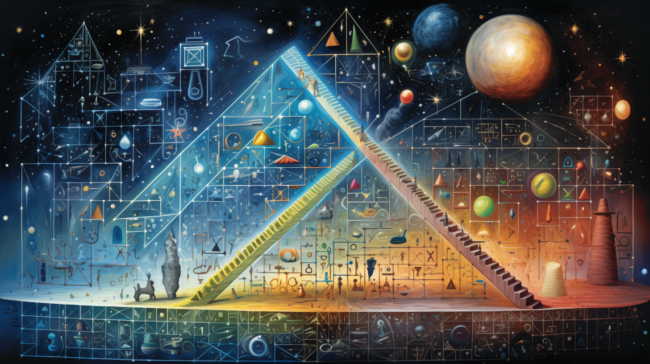
Introduction
The intricate dance between mathematics and science has always been a subject of fascination. Historically, the realm of pure, theoretical mathematics was often viewed as just that — theoretical. Many viewed it as a field of abstract concepts with little to no bearing on reality. However, this perception has been challenged repeatedly throughout history as concepts developed in the realm of abstract math found in real-world science have paved the way for groundbreaking discoveries in real-world science. This blog post will delve into these historical instances, shedding light on the profound and sometimes unexpected ways that abstract mathematics has contributed to our understanding of the tangible world.
The Unexpected Bridge: Abstract Math in Practical Use
Pure mathematics, the study of mathematical concepts independently of their application, has long been considered a field of abstract intellectual exercise. For centuries, many scholars and laypeople alike believed these concepts existed solely in the realm of theory. However, history has shown us that this is far from the case. There have been key moments when theoretical mathematics not only found practical application but also drove scientific innovation.
One of the first instances of such a bridge between abstract mathematics and practical use was the development of calculus by Isaac Newton and Gottfried Wilhelm Leibniz in the late 17th century. Initially a theoretical framework, calculus soon became instrumental in formulating classical mechanics, explaining the motion of celestial bodies, and predicting natural phenomena.
When Abstract Mathematics Met Quantum Physics
The field of quantum physics, perhaps more than any other, showcases the profound impact of mathematical concepts on scientific discovery. The early 20th century saw the birth of quantum theory, with Max Planck’s revolutionary quantum hypothesis in 1900. The hypothesis posited that energy is emitted in discrete units or “quanta.” This concept clashed with the classical notion of continuous nature. This hypothesis laid the groundwork for a new realm of physics and required the formulation of new mathematical structures.
Subsequently, Erwin Schrödinger introduced his famous wave equation in 1926, rooted in mathematical analysis and wave mechanics. It soon became a fundamental equation in quantum mechanics. This equation provided a way to calculate the likelihood of finding a particle in a particular position. It drastically transformed our understanding of atomic and subatomic particles’ behavior.
Another striking example of abstract math in real-world science is the application of non-Euclidean geometry in Einstein’s theory of relativity. Before Einstein, geometry, as described by Euclid, posited that parallel lines do not meet and the angles of a triangle add up to 180 degrees. However, Einstein discovered that in the presence of gravity, space becomes curved, and Euclidean geometry no longer holds. This realization led to the incorporation of Riemannian geometry into his General Theory of Relativity in 1915. And it revolutionized our understanding of gravity, space, and time.
The Role of Abstract Math in Chemistry
Abstract mathematics has also found surprising applications in chemistry, aiding in the understanding of molecular structures, reactions, and behaviors. One significant instance is the use of group theory, a study within abstract algebra, in molecular symmetry and chemical spectroscopy. This mathematical framework helps chemists predict molecular properties, understand the nature of chemical bonds, and explain the structures of complex molecules, such as buckminsterfullerene, a molecule with 60 carbon atoms arranged in a closed shell, discovered in 1985.
Differential equations, another area of abstract mathematics, play a crucial role in chemical kinetics, the study of reaction rates. These equations model the way concentrations of reactants and products change over time, providing insights into reaction dynamics and equilibrium. For example, the famous rate equation known as the Michaelis-Menten kinetics, formulated in 1913, uses differential equations to describe the rate of enzymatic reactions, crucial in various biochemical processes.
Further Instances of Theoretical Math in Real-World Science
The influence of abstract mathematics extends beyond the realms of physics and chemistry, weaving its intricate patterns in various facets of the world around us.
One such fascinating instance is the appearance of the Fibonacci sequence in nature. This sequence, introduced in 1202 by Leonardo of Pisa, known as Fibonacci, involves a series of numbers where each number is the sum of the two preceding ones, starting from 0 and 1. Astonishingly, these numbers frequently occur in plant structures. For example, the number of petals on flowers often follows the Fibonacci sequence — lilies have three petals, buttercups five, chicory 21, daisies can be found with 34, 55, or even 89 petals. This mathematical principle, once deemed purely theoretical, underlies the very arrangements of growth in nature.
Topology, another branch of abstract mathematics, has profound implications in material science. This field, concerned with properties preserved through deformations, stretching, and twisting of objects, has been instrumental in predicting the properties of new materials. One notable application is in the study of topological insulators — materials that behave as insulators in their interior but whose surface contains conducting states. These materials, first observed in the 2000s, have unique electronic properties that are robust against impurities, making them potentially useful in quantum computing.
Chaos theory, a branch of mathematics focusing on systems highly sensitive to initial conditions, dramatically influences meteorology. The “butterfly effect,” a term coined by meteorologist Edward Lorenz in the 1960s, posits that small causes can have vastly larger effects, such as the proverbial butterfly flapping its wings in Brazil causing a tornado in Texas. This theory revolutionized weather prediction and our understanding of complex dynamical systems.
Beyond Coincidence: Why Abstract Math Finds Its Way into Reality
The recurring emergence of abstract mathematical concepts in tangible scientific phenomena is no mere coincidence. Mathematics, often termed the “universal language,” seems to underpin the fabric of reality itself. But why do these abstract concepts find their reflections so vividly in the world around us?
One perspective is mathematical realism, which suggests that mathematical entities exist independently of the human mind. From this viewpoint, humans do not invent mathematical truths but rather discover them. The physical universe, in all its complexity, follows these truths, leading to the practical manifestations of abstract mathematical concepts.
Prominent mathematicians and scientists have long pondered this intricate relationship. The great physicist Eugene Wigner, in his seminal paper “The Unreasonable Effectiveness of Mathematics in the Natural Sciences” (1960), discusses the “miracle” that abstract mathematical concepts often find perfect applications in the physical world, a phenomenon that remains partially shrouded in mystery.
Conclusion
The journey from abstract mathematical concepts to their unexpected emergence in real-world phenomena is a testament to the interconnectedness of knowledge. These instances, spanning various fields of science, illustrate that abstract mathematics is a foundational element in our quest to decode the universe. The theoretical realm of mathematics, far from being a sterile place of numbers and equations, is teeming with ideas that the physical world seems eager to embody. These connections remind us that science and mathematics, reality and abstraction, are not dichotomies but rather intricately woven together. Whether through the precise language of mathematics or the observable phenomena of science, we continue to unravel the mysteries of the cosmos. We then find along the way that sometimes, the most abstract of concepts illuminate the path to understanding.


Leave a Reply